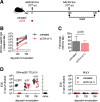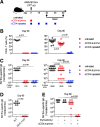Transient CD4+ T Cell Depletion Results in Delayed Development of Functional Vaccine-Elicited Antibody Responses
- PMID: 26865713
- PMCID: PMC4836333
- DOI: 10.1128/JVI.00039-16
Transient CD4+ T Cell Depletion Results in Delayed Development of Functional Vaccine-Elicited Antibody Responses
Abstract
We have recently demonstrated that CD4(+)T cell help is required at the time of adenovirus (Ad) vector immunization for the development of functional CD8(+)T cell responses, but the temporal requirement for CD4(+)T cell help for the induction of antibody responses remains unclear. Here we demonstrate that induction of antibody responses in C57BL/6 mice can occur at a time displaced from the time of Ad vector immunization by depletion of CD4(+)T cells. Transient depletion of CD4(+)T cells at the time of immunization delays the development of antigen-specific antibody responses but does not permanently impair their development or induce tolerance against the transgene. Upon CD4(+)T cell recovery, transgene-specific serum IgG antibody titers develop and reach a concentration equivalent to that in undepleted control animals. These delayed antibody responses exhibit no functional defects with regard to isotype, functional avidity, expansion after boosting immunization, or the capacity to neutralize a simian immunodeficiency virus (SIV) Env-expressing pseudovirus. The development of this delayed transgene-specific antibody response is temporally linked to the expansion of de novo antigen-specific CD4(+)T cell responses, which develop after transient depletion of CD4(+)T cells. These data demonstrate that functional vaccine-elicited antibody responses can be induced even if CD4(+)T cell help is provided at a time markedly separated from the time of vaccination.
Importance: CD4(+)T cells have a critical role in providing positive help signals to B cells, which promote robust antibody responses. The paradigm is that helper signals must be provided immediately upon antigen exposure, and their absence results in tolerance against the antigen. Here we demonstrate that, in contrast to the current model that the absence of CD4(+)T cell help at priming results in long-term antibody nonresponsiveness, antibody responses can be induced by adenovirus vector immunization or alum-adjuvanted protein immunization even if CD4(+)T cell help is not provided until >1 month after immunization. These data demonstrate that the time when CD4(+)T cell help signals must be provided is more dynamic and flexible than previously appreciated. These data suggest that augmentation of CD4(+)T cell helper function even after the time of vaccination can enhance vaccine-elicited antibody responses and thereby potentially enhance the immunogenicity of vaccines in immunocompromised individuals.
Copyright © 2016 Provine et al.
Figures







References
-
- Fulcher DA, Lyons AB, Korn SL, Cook MC, Koleda C, Parish C, Fazekas de St Groth B, Basten A. 1996. The fate of self-reactive B cells depends primarily on the degree of antigen receptor engagement and availability of T cell help. J Exp Med 183:2313–2328. doi:10.1084/jem.183.5.2313. - DOI - PMC - PubMed
Publication types
MeSH terms
Substances
Grants and funding
LinkOut - more resources
Full Text Sources
Other Literature Sources
Medical
Research Materials

